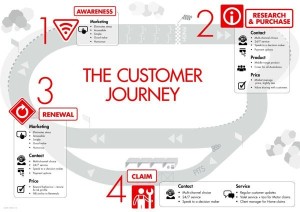Agencies that have relied on traditional channels to build and grow personal relationships face a future in which conversations and in-person meetings have become the equivalent of landline phones and cursive writing.
If you never meet the customer, how do you get to know them? Just as you trained staff to ask the right questions and read body language, you need to learn to decipher the digital footprints that your customers leave behind. By applying advanced analytics, you can predict customer behavior and deliver a highly personalized communication or offer at the moment when the customer is most receptive to receiving it.
 Analyst firm CEB TowerGroup estimates that 75 percent of US banking transactions in 2012 came from digital channels. By 2016, that percent is expected to rise to 84 percent. Today, online transaction volumes are more than double that of branch activity. Bank employees have fewer opportunities to say, “Is there anything more we can do for you?” But lets look at this and say whats next for the independent insurance agency? Are we allowing our clients to be digital and if not are we going to end up like bank tellers? These are very important questions to ask ourselves.
Analyst firm CEB TowerGroup estimates that 75 percent of US banking transactions in 2012 came from digital channels. By 2016, that percent is expected to rise to 84 percent. Today, online transaction volumes are more than double that of branch activity. Bank employees have fewer opportunities to say, “Is there anything more we can do for you?” But lets look at this and say whats next for the independent insurance agency? Are we allowing our clients to be digital and if not are we going to end up like bank tellers? These are very important questions to ask ourselves.
Big data vs. small data
Finding a way to personalize offers involves making sound decisions on which data is meaningful, and in what context. Customer analytics tends to get conflated with the phrase “big data,” but success is just as dependent on “small data.” What’s the difference? Small data is knowing something specific about your customer/client, such as he just purchased a motorcycle. Big data crunches information to compare a customer’s transactions or purchases and demographics against similar customers to segment that customer for marketing offers. Both involve analytics, but not in the same way but both are very important in how we attain the information and what we are going to do with the information.
Lets Find a starting point
Being able to segment customers is a critical starting point, the first stop in ending the “one size fits all” approach to customer communication. Your analysis needs to review customer behavior data to develop insight into how they will respond going forward. No two institutions will have the same segments, and savvy institutions are constantly honing and reworking segments as new information becomes available. Offer-response rates can be looped back into model building. Increasingly, understanding online behavior (how a customer moves through a website or app) is critical to successful segmentation. This is exactly what Facebook and other social avenues are gathering and then selling that data to understand prospects buying habits. Along with this I would recommend doing surveys with your clients and how we do this is with a digital marketing on-boarding system with each and every new client. We want to gather data on why they may have purchased insurance from our agency but another survey goes out 90 days prior to the renewal because after we gather the data from the first survey we want to find out the experience they have had with our agency over the past 9 months why you may ask is because if we didn’t live up to there expectations we have reach out to them and figure out how we can improve along with saying Sorry and that 90 days will be focused on getting them back on our side to renew their policy. We need to listen to our clients!
Laying in optimization~ Real-time strategies
Let’s think about the customer who made an expensive car purchase such as a Telsa. You want to get the right offer in front of him with the right coverage because if we don’t handle that properly he maybe calling our competitor, lets remember many of our clients leave and or shop after and auto is added because of several reasons one is they didn’t care for the service or they received a price they didn’t care for. If your analytic efforts surface that information about the large purchase a month or a week later, it might be too late. The agency should have a congratulation card out to that client someday he added that care onto his policy and maybe along with it is a Dunkin Donuts gift card(if allowed by your states insurance regulations). This is where it becomes critical to optimize the process and use real-time monitoring. Optimization does more than create the right offer and the right means to get it in front of the customer. It calculates the opportunity cost of not making the offer. Yes every BIG purchase should trigger a communication.
The real-time component makes sure that if an offer is necessary, it happens as quickly as possible and while the customer is still in-session. And the offer should be tailored to what she’s done or liked in the past. If one customer responds to a direct email, social media or text message, that might be the approach to take. For another customer that tends to engage one way doesn’t mean all engage that way we need to have the ability to adopt and communicate the way they want to be communicated with.
Customers like feeling that you and your agency are out to ‘get them’
Some agencies are concerned that customers will find this kind of marketing or information gathering intrusive . The reality is quite different. Despite privacy concerns, customers expect that you will know them: 60 percent said so in a 2013 SAS survey of 1,260 US respondents. They want recommendations for products and services based on their lifestyle, previous purchases and search history. Years of shopping on sites like Amazon, Google and Zappos that offer personalized recommendations based on search patterns condition customers to expect this. This level of personalization is becoming a factor in how customers view service quality. Online retailers get high ratings, where industries that typically shy away from customized offers fare worse like insurance.
Conceptualization to Reality
Being able to optimize and place offers in real time involves a few easily overcome technology hurdles. Insurance agencies have not invested in segmentation and personalization to the degree online retailers have. The first step is to recognize that if your customer analytics doesn’t monitor digital paths and can’t be done with optimization or real-time options, it won’t be effective. Many other industries use analytics providers that offer a report on overall website activity, not the kind of personalized data that can be read as it streams in to the site. Website tags that allow agencies and other industries to track how a customer interacts with a digital channel haven’t been readily available in the past. Additionally, all of this data is useless if you can’t merge the online and offline data to build the profile that allows you to know that prospect or client.
Luckily, insurance agencies don’t need to create this from scratch. Customer experience personalization solutions exist that can help by:
- Capturing the complete online behavior of the customer and accurately associating it with data from other sources (including transactions with the use of your agency management system).
- Matching this behavior to a library to you’re marketing efforts, reworking what is stocked on the library “shelves” as you see what clients respond to.
- Striving to constantly deliver the best service, not just saying it.
These types of solutions offer solid payoffs for an agency. Among the successes:
- Our agency has increased target audience members by 200 percent at the same time it cuts traditional marketing cost of 10 percent.…
- More targeted campaigns digitally and improved customer service through our Agency App and surveys along with our much improved digital presence has help our agency bottom line grow in double digits.But with that aid it’s an ever changing buyer so we must continue to evolve and continue to change and adapt with how our clients/prospects want to communicate with us
Yet, customer service is critical — whether customers are in front of you or at their computers. A 2012 Forrester Research report, The Business Impact of Customer Service, calculates that a bank with 40 million customers would gain $485 million in incremental revenue by improving its customer experience rating from below average to above average. Well, here I go again comparing an insurance agency to a bank and the reason why Im doing this is because of how direct writers are turning auto insurance into a commodity. Well, the two go hand and hand bank tellers are disappearing to online banking and the use of an App and we in the insurance industry are slow to adopt those same technologies that clients of banks are adopting. We in the insurance industry to adopt what our prospects and clients want NOT what we think they want we need to listen and see whats happening and then implement. Its time for us agents to really pay attention to whats going on in the banking world because we too are effected just as they are.





